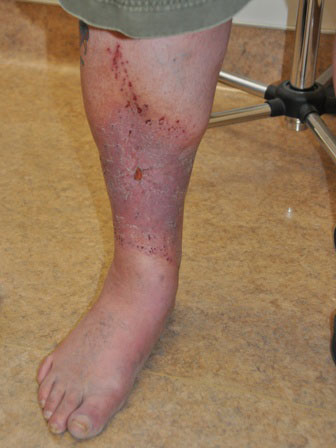Leg Ulcers (Venous Ulcers)

Symptoms
Leg ulcers have a characteristic location in the middle part of the ankle just above the ankle bone (medial malleolus). The reason venous ulcerations tend to form at this location is that this is usually the location of the highest venous pressure caused by venous insufficiency (damaged veins). The wound usually causes the skin to be discolored. It can swell, itch, cause pain, and smell.
Risks and Causes
Some risk factors that can lead to vein ulcers are smoking, obesity, previous injuries, and older age. Leg ulcers can be a serious condition as they can cause infection, swelling, and pain. The majority of venous ulcers are caused by venous insufficiency. However, some ulcers can be caused by arterial disease. Also patients who have experienced blood clots or deep vein thrombosis can be more at risk to get a leg ulcer.
Diagnosis
It is crucial to treat the underlying cause of venous ulcers which is typically venous insufficiency. This helps to reduce venous hypertension in the leg. However, not addressing the root cause can lead to recurrence of the ulcers within 6 to 12 month. At the San Francisco Vein center, we take venous ulcers and leg ulcers very seriously. We take the time to find the underlying cause of the ulcer using vascular ultrasonography.
Treatment
Untreated, venous ulcers can linger indefinitely. It is important to treat them as they can also cause damage to nearby tissue. We formulate an individual treatment plan for our patients using a combination of the following treatments:
- Radiofrequency ablation or laser ablation is a treatment for patients with venous insufficiency
- Compression stockings, therapy and dressings
- Elevation
- Antibiotics to help fight infection
- Skin grafts replace damaged tissue once the wound is stable
- Surgery is sometimes necessary
Recovery
Venous ulcers can take a long time to heal. We coordinate care with multiple specialists. However, with proper treatment of the underlying vein insufficiency, recovery can take months. Because of the extensive damage leg ulcerations can cause, they can require significant health care expenses and dedication of time to doctor visits. As one can imagine, leg ulcers have a very significant impact on quality of life. Their presence can lead to significant impact of social life, disability, and even loss of a limb.
